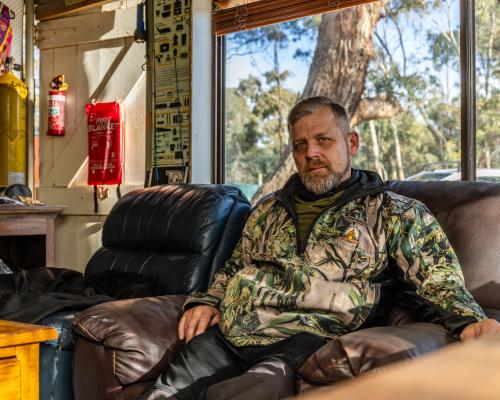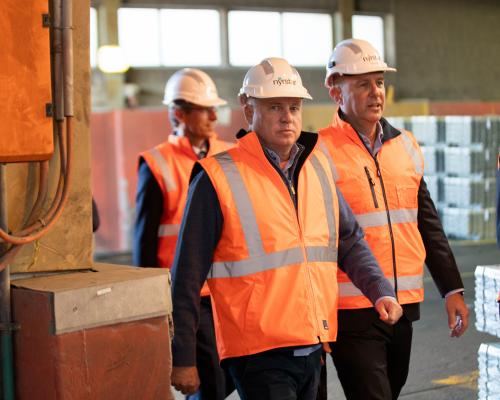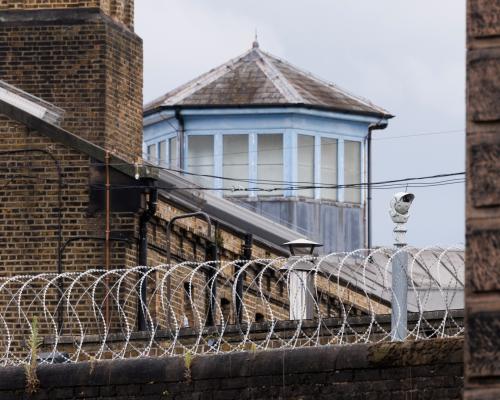
Shortly after Israel announced its attack on Iran in June, Trevor Andrei sent a message to some of his fellow Australian preppers telling them to stock up on petrol and buy a few hundred dollars’ worth of groceries.
“I was like, OK, this is super significant, there’s going to be a response … shit’s going to go down,” Andrei says. “Most years, [Australia is] lucky if we’ve got 28 days [of petrol reserve] so … if anything hits the world’s oil supply, we can be out of petrol in a month.”
Andrei describes himself as Australia’s most famous prepper and is one of the few happy to speak publicly about a famously secretive subculture.
The survivalist runs bushcraft courses (two hours for $299), makes and sells soap with his daughter, makes his own jerky, and has a property with fruit trees and a dam full of rainbow trout. He has great relationships with his farmer neighbours, he says – he’ll process lambs mutilated by foxes so that the meat can be shared around the community for pet food, and when a tree comes down on one of their properties, Andrei will chop it up in exchange for some of the haul. He has formerly worked as a landscaper specialising in edible gardens and a tour guide in the outback.
In short, when shit hits the fan (SHTF, in prepper parlance), Andrei is going to be all right.
He’s not so sure about the rest of us.
“Shit hits the fan every day,” he says. “It just matters how close you are to the fan and whether or not it splattered on you, right? But the real shit hits the fan is what we call a fire sale, right? And that’s where it’s literally everything that could go wrong has gone wrong … So the pointy end of the scale is, you imagine like a cyberwar: there’s no gas, there’s no water, there’s no electricity, you can’t flush your toilet, there’s no radio.
“Every single day of your life you have expected to … put some food on a plate and stick it in your mouth. So why would you not prepare for that ahead of time? There are so many people who don’t do it.”
And yet increasingly, it seems, there are more and more people across Australia who do.
Global instability and the abrupt arrival of AI are among the factors that have pushed prepping towards the mainstream. But the biggest driver was the pandemic, when people experienced empty supermarket shelves and the pain of disrupted global supply chains – some for the first time in their lives.
For preppers such as Andrei, who see how most urban Australians live, this move towards preparedness cannot come soon enough.
“Prepping is becoming super super super popular. I’ve got schools that want me to teach it,” he says. “You’d be mad, anybody would be mad if they’re not sitting there going, all right, what’s going on? And what should we do?”
‘In cities there’s so many fragile people’
Sam and Candice Johnson are not preppers, but they deal with preppers almost daily.
“We’re just country-prepared, as we say,” Candice says. “We’ve always got that little bit of extra in case you get flooded in or you have to leave home quickly in case of fires, but other than that I wouldn’t consider ourselves preppers.”
The couple run a camping store in Beaudesert, Queensland, an hour west of the Gold Coast. A little over a decade ago, they saw a gap in the market and began stocking emergency kits – containing items such as wind-up radios, torches, batteries and glowsticks – to have on hand in the event of natural disasters.
-
Sign up for a weekly email featuring our best reads
But over the years, customers began asking if they could stock more serious survival supplies. Now the store supplies most of the country with everything from freeze-dried foods to mylar bags, fire-starting kits, camouflage netting, snares and traps.
“The majority of our customers are those who want to be long-term prepared, so they’re the people who’ve got, you know, a couple of months’ worth of food stored away, or they’ve got emergency water filters,” Candice says.
“When we started … [prepping] was a really underground, quiet kind of thing. But that’s increased 10-fold, twentyfold, thirtyfold.”
Covid was a big factor, she says. “People who didn’t understand what the whole thing was about previously, now had some kind of context as to why other people were doing it.”
That removed some of the stigma as well. “People are seeming less quiet about it. Before we’d get lots of customers who wouldn’t give us their name and they’d only pay cash and all this sort of stuff, but now, people are much more open and accepting of it and willing to admit that it’s something that they do.”
Bradley Garrett, a geographer who has researched preppers around the world, interviewing more than a hundred of them for his book, Bunker, says there is a distinct difference between Australian preppers and those in the US, that seems to stem from a different level of trust in the government.
“My experience talking to preppers in Australia is they’re much more concerned with practical prepping, as we call it – prepping for a wildfire or a blackout for three days or a week, or the taps turning off, or whatever. It seems to me like there is an expectation that help is going to arrive at some point … whereas with American preppers, they’re much more concerned that help is not going to arrive and you’re on your own. And that’s certainly become exacerbated under the second Trump administration.”
Garrett says there is a lot more openness towards prepping in Australia than in the US, largely because of a culture “of loading up your overland vehicle and going out to campsites and staying out for multiple days”. But there is also a huge split between the preparedness and resilience of people in cities and those in rural areas.
“In cities, God, there’s so many fragile people that are totally dependent upon the next paycheque and systems being in working order … There are a lot of people who really would not fare well in a dire emergency.”
Garrett says when he started researching prepper culture he was one of these typical, fragile, middle-class Sydneysiders.
“When I had my position at the University of Sydney and I had a steady paycheque and we went to the gym and we did all the things that you do as a middle-class Sydney person, it was fine, there was nothing wrong with it, but the more I talked to these people, the more I realised, if something went wrong with this, I couldn’t deal with it. Like we had no reserves, we had no resiliency.”
Garrett eventually adopted some prepper practices: he came up with a plan for what to do if he turned the taps on one day and no water came out.
He had a Jeep packed with camping gear and a “mental map” of his surroundings and a plan for where he could go if his city home became unsafe (drive his Jeep south into the national park) as well as a backup plan – a few kayaks tied up on a nearby beach, so he and his wife could “take to the water” and get out of the city that way.
“I started thinking more about how much money do we have in the bank, and what resources do we have if suddenly the grocery stores weren’t open, you know?
“People don’t necessarily need to move, but creating a little elasticity in your existence so you can deal with crisis is a very healthy thing.”
‘Bug in’ or ‘bug out’?
On one of Australia’s most popular prepper Facebook pages the discussion bounces from the mundane (“Does anyone have any recommendations for good quality but affordable Mylar bags and oxygen absorbers?”) to the portentous: “When China spits the dummy with Australia, the sea lanes will be cut and our imported food will stop. Stock up on all you can.”
In between posts offering advice on the best storage of rice (white apparently stores much better than brown – “the lesser of two weevils,” a commenter quips) – and the discussion about the battery life of the Nokia 3210, there are questions about the best mode of transport. “When the lights go out … do I need to purchase horses? Camels?”
Others present detailed plans of how people would or should survive should the worst happen.
One user posts an ominous checklist of what to do on “day one … immediately after the collapse”. The list runs: secure your perimeter, fill bathtubs and bowls with water while it’s still running, radio check your crew and decide whether to “bug in or bug out”, but make that decision early, as “traffic jams and gunfire don’t mix”.
Whether to “bug in” or “bug out” is a key question for hardcore preppers. Bugging in means people plan to stay put in their home, which should be well stocked with supplies, well hidden and whose existence should not be disclosed to anyone, lest marauders come.
Bugging out means leaving, with either a “bug out bag” – a short-term emergency kit – or an Inch (I’m never coming home) bag with supplies to enable indefinite survival.
Andrei plans to bug in, but thinks building a bespoke bunker full of supplies is quite stupid. That would make them a “soft, high-yield target” for “wolves” – his term for marauders who would seek out a bunker, smoke out the occupants and steal their supplies.
Holly Robertson, who identifies as a “bush survivalist” rather than a prepper, agrees.
“So, I don’t identify with prepper culture, but I do see myself as someone who’s prepared. When people know that you have a stockpile, that’s where they’re going to go first. But if you’re someone who can literally take a knife or a machete and go into the bush and make your own fire friction kit and make your cordage and make your traps, that’s powerful. Like, that’s a skill set that people really value. They’re not going to try and steal from you, they want to have you in their space. So for me, leading with skill set and knowledge is far more powerful than having a stockpile of things.”
Robertson stands out from many in the bush survivalist community for a few reasons: she is 25, female and has an Instagram account with nearly 55,000 followers.
She became interested in this world a few years ago when she was holidaying near Byron Bay. She went to a bush survival school run by a man known as Cockatoo Paul, who would eventually become both her life and business partner.
Paul died a year ago, and Robertson now runs the Australian Bush Survival School as a mobile business, travelling all over Australia to run everything from children’s workshops to corporate retreats, teaching skills such as trapping, tracking, spear throwing, knot-tying, skin tanning, friction fires, water purification and basic navigation.
“At the end of the day, the majority of the skills I teach people, they’re probably never going to use again in their life. I hope they’re never in a survival situation. But what I do see is a sense of empowerment and confidence through capability. When someone, for the first time in their life, creates a fire out of two sticks, the way their face lights up is phenomenal.
“A lot of people … in my generation … they don’t know how to light a fire. And if the power went out, they would have literally no idea what to do whatsoever. A lot of our grandparents, they’ve lived in the bush and they’re super capable … so what I really want to see for my generation is how we can really step up and become more self-reliant.”
‘It’s not fine to obsess’
While many interviewees stress the importance of resilience, capability and community, some also warn there can be a dangerous element to prepper culture.
“Unfortunately some very vulnerable people fall into that demographic and they find a lot of serious consequences down the line,” says John Scarinci, the secretary general of the Australian Peoples Survival League (formerly the Australian Preppers Survival League).
Scarinci says for some people, prepping can become a “life-overtaking exercise”.
“They find themselves in trouble later in life because they’ve just spent their life savings [and] years roll on, decades … and they’ve amassed a huge amount of preparatory items and they’ve forgotten about their own health and wellbeing, and the world has not collapsed and they find themselves in a spot of bother.”
Some find they have spent decades preparing for the end of the world, but not for retirement or aged care. For others, prepping comes at huge cost to relationships.
“Their partners may potentially leave them because they’re so fixated with their preparations, where they’re preparing for the doomsday occurrence and it just engulfs them. They’re unable to work, because how are you going to fit in … a career whilst being fixated on preparing your jars of food and your freeze-dried items?”
Garrett says he has also seen people who started prepping on a “low level”, dedicating more and more of their resources and mental energy to it.
“Eventually families start to get frustrated [and ask] ‘What are we doing here? We’re spending more time anxious about the future than we are worrying about the present, or enjoying the present.’
“It happens a lot, because prepping is a thought experiment, so once you start to think, ‘How do we escape from a bushfire?’ then you start thinking, well, what if there was a nuclear attack? What if all the cyber systems are down and we have to flee? What if AI turns on us? It can become a bridge to conspiracy theory and the guardrails you have to put in place are just understand that, yeah, it’s fine to think about these things, but it’s not fine to obsess over them.”
But Garrett says becoming more prepared has made him far more peaceful, rather than anxious.
He eventually moved away from his middle-class Sydney life, returning to his native US, where he lives on a five-acre property in rural California. He and his wife grow their own food, have horses and are gradually taking the property off-grid.
“Things can definitely go wrong in our lives and I’m totally capable of dealing with them … It’s given me a sense of solace that not only do we have the resources we need to get through something, but I’ve spent years now upskilling in various things … I just learned how to lay pipes in the yard … or I learned how to put in an electrical socket or fix our breaker if it goes out. All those sort of DIY practical skills. Every time I learn something, then I think, ‘Oh this is fantastic’ because if something goes wrong, I don’t have to call someone to deal with this – I can deal with it.”






